Tips For Painting
Accent Walls
Painting accent walls is a great solution for those who want to dress up their living space but are not yet ready to commit to a full room's worth of color.
But even if you are not afraid of using color everywhere, focal walls can really spice things up and create a fresh new look with minimal cost and effort.
An accent, or feature wall in a room is like an exclamation mark at the end of a sentence - it adds excitement and importance to the space.
By painting an accent wall, you can create a sense of architecture and shape in a boxy room, direct the eye strategically to where you want it to go or emphasize an existing focal point.

But in the wrong place it will only look odd and confusing, that's why picking the right wall to feature is so critical.
Unlike what most people think, the first wall that you see when you enter a room is not always the best one to accentuate.
In fact, there
are many more decisions involved, and the following guidelines will help you determine which wall to choose.
NOTE: interior designers and home decorators often break all these rules yet create a masterpiece of a room. Beginners? Not so much.
So unless you really know what you are doing, you will probably want to stick with these safe, mistake-proof suggestions for painting accent walls - that way you are pretty much guaranteed to create professionally looking results.
Best Practices for
Painting Accent Walls:
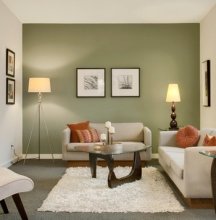
- Accent walls look best when they are solid - meaning they have no doors or windows.
You may be tempted to "frame" your beautiful french doors or the large windows with a spectacular view, but oftentimes this will only distract instead of enhancing.
And besides, the light from the windows will usually make the accent color look dark or virtually invisible during the day.
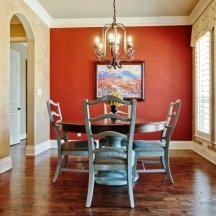
- In a really oblong room, the best wall to accentuate is the farthest short wall - the accent color
will draw attention and make the wall appear closer to you, visually
correcting the shape of the room. Painting the longest wall differently
will only emphasize its length.
For this reason, accentuating shared walls (those common in open floor plans) is seldom a good idea. Not only will you have trouble deciding where to start and stop (if the wall spans the kitchen and living room, for example), but you will also make the space look disproportionately elongated and unbalanced.
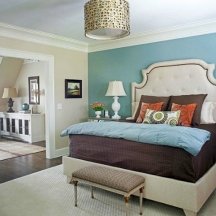
- Do you have a focal point in the room already? Because it's usually better to highlight the existing point of interest than
create a new one.
For example, if you have a fireplace, that's a built-in, natural focal point that is already present in the room (no need to create something different), but you can make it stand out more by painting the wall it's on a different color than the rest. That way you'll be working with it, not competing against it.
Other "naturals" include the wall behind your bed's headboard or an important piece of furniture (usually your couch), the wall holding some dramatic artwork, a niche or other interesting architectural wall feature that already attracts attention.
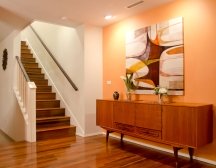
- When there is no natural focal point in the room, you can create one.
Select the best wall for accent painting (keeping in mind the above
suggestions), then look around - what do you want to showcase?
Maybe you have a favorite painting or a collection of framed photos, a unique piece of furniture or even a live plant that you really love? On the background of the accent wall color, that item will be in spotlight and get more attention.
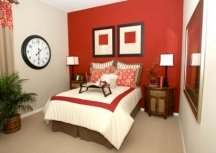
- Before painting an accent wall, make sure there is no
competition from the other walls in the room.
If any of the adjacent walls has some "bossy" or "in your face" element that already draws all of the attention (such as an oversized mirror, dramatic artwork or other bold wall decor), adding an accent wall next to it may easily create confusion and overwhelm the space - in that case, thread carefully.
Remember that if something in the room is the star of the show, the other elements of the decor should play quieter, supporting roles (so don't force an accent wall in a room that doesn't lend itself to it - leave rule breaking to the pros).
And that brings us to choosing color for painting accent walls...
Color Advice for
Painting Accent Walls
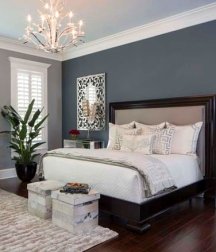
- Accents walls look most organic when they are darker than the other walls in the room - it's a classic look.
A reversed color combination is possible (e.g. a light accent wall in a room painted a deeper color) but requires skill and a good eye for color and decorating, so beginners will be better off sticking with the traditional color placement.
Also, the color of the accent wall should harmonize with the adjacent wall color. When in doubt, paint your statement wall the same color but 2 shades darker than the rest - it's always a foolproof look.
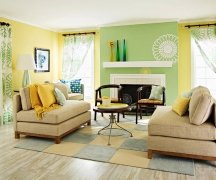
- Make sure the accent wall is related to the existing decor. The best way to connect it is to repeat one of the colors already present in the room.
Take a look at your throw pillows, artwork or other decorative pieces and use one of the colors for painting the accent wall.
Just don't pick the dominant color in the decor (for example, the color of your furniture upholstery and curtains), otherwise you'll end up with too much of the same thing and when everything is emphasized, nothing is emphasized.
And please don't match it to your boring beige carpet - you can do better than that when it comes to color inspiration!
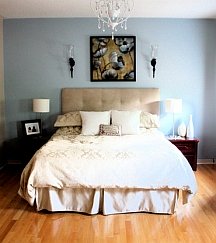
- When choosing a paint color for the accent wall, consider the items that will be placed on its background.
You need to ensure there is enough contrast, and that the colors will coordinate well - you don't want your furniture pieces, wall art and other decorations to clash with the wall color, or blend in and disappear on the new color background.
If you are experienced in decorating with paint, accent walls can help you make quite a statement. For those who are new and not used to bold colors, adding an accent wall is a good place to start experimenting with possibilities.
See Also:
Creative Accent Wall Painting Ideas
Painting Rooms to Manipulate the Space
Decorative Interior Painting Tips for Foyer Walls









Leave a Comment: